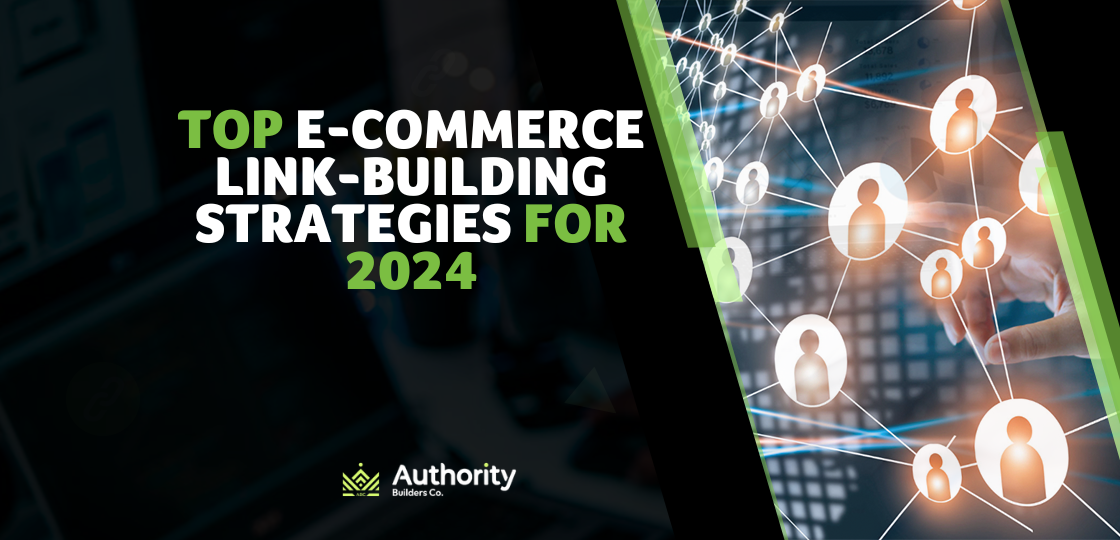
In SEO, link building is the process of getting other sites to link back to your own.
Think of it as a popularity contest: the more reputable sites that vouch for you (through links), the more Google sees you as a trustworthy and valuable source.
Why does this matter?
Google’s mission is to deliver the most relevant results to its users. Backlinks act as a signal of your site’s quality, essentially telling Google, “Hey, this site is worth checking out!”.
This credibility boost translates to higher rankings in search results, leading to increased visibility and organic traffic.
But it’s not just about SEO.
Backlinks (also known as inbound links) can also drive referral traffic directly to your site. When readers on other relevant sites click on a link to your content, you’re tapping into new audiences and expanding your reach.
So, link building is not just a tactic—it’s a fundamental part of a successful online strategy.
It’s about building relationships, establishing authority, and ultimately growing your ecommerce business.
Contents:
Commonry: A Case Study in Link Building Success
Link Building Strategies for Ecommerce: A DIY Guide for Business Owners
Final Thoughts: Ecommerce Link Building
Commonry: A Case Study in Link Building Success
| 💡New to link building? Start your journey with Matt Diggity’s YouTube playlist, specifically designed to walk you through the fundamentals in a clear and easy-to-understand way. |
Link building isn’t just an abstract concept; it directly translates to more eyes on your products or services. Just look at Commonry, an online clothing retailer that harnessed the power of backlinks to fuel their growth.
The graph below paints a compelling picture: as Commonry’s referring domains (blue line) climbed, their organic traffic (orange line) followed suit, indicating a significant boost in website visitors and potential customers.

Source: Ahrefs
Link Building Strategies for Ecommerce: A DIY Guide for Business Owners
Feeling inspired by Commonry’s success? The good news is that you don’t need a massive budget to fund your ecommerce link-building strategy.
Whether you’re a seasoned online retailer or just starting, there are plenty of actionable strategies you can implement to boost your site’s authority and visibility.
Let’s explore some actionable strategies you can implement today to build valuable bridges to your online store.
Get active on social media
Before we get into actual ecommerce link-building tactics, the first thing you’ll need to do is to optimize your social media. After all, social media isn’t just a place to share memes and vacation pics—it’s a powerful tool to amplify your link-building efforts.
| 💡Does social media give you a rankings boost?
A “pillow link” is a type of backlink used in SEO that is low-risk and low-impact. These links, such as those from social media profiles, help create a natural and balanced backlink profile for your website. Although pillow links don’t significantly boost your search rankings, they are important because they show Google that your brand is active and engaging with people online. This helps make your overall link profile look more organic and healthy. Aside from social media profiles, here are some examples of pillow links:
|
Let’s dive into how website owners can leverage their social presence to attract those coveted quality links.
1. Optimize your social profiles
The foundation of your ecommerce link-building strategy starts with your profiles. Ensure that every profile, whether personal or business-related, is up-to-date and features a working link to your website. This includes:
✔️ Personal profiles
✔️ Business pages like Google Business
✔️ Group pages
For instance, on platforms like Facebook, take advantage of multiple opportunities to link to your ecommerce site, such as in your profile’s “About” section, posts, images, videos, and even pinned posts in your groups.
2. Share your website content
Sharing high-quality website content (more on this later!) across your social platforms is the next step.
Make it easy for yourself and your audience to share your blog posts, articles, and product pages by integrating social sharing buttons on your website.
Consider using both floating and fixed share icons, like those found in popular blogs, to ensure that your content is easily shareable from any position on the page.
The more your content gets shared, the more eyes will be on it, increasing the chances of others linking back to it.

Source: Niel Patel
3. Explore niche-specific platforms
Don’t limit yourself to the major social media players. Explore niche-specific platforms where your target audience hangs out.
For example, if you sell fitness-related products, consider sharing your content on platforms like Strava or fitness-focused subreddits like r/fitness.
By actively participating in these communities and sharing your valuable insights, you can build relationships and establish yourself as an authority, which can naturally lead to backlinks from other members.
Find unlinked mentions and ask partners to link to you
An unlinked brand mention is when another website mentions your brand, product, or service without including a hyperlink back to your site. These mentions are missed opportunities for valuable backlinks.
Here’s how to turn unlinked mentions into ecommerce backlinks:
Monitor your brand mentions
To effectively monitor unlinked brand mentions, you can utilize both free and paid tools:
Google Alerts (Free)
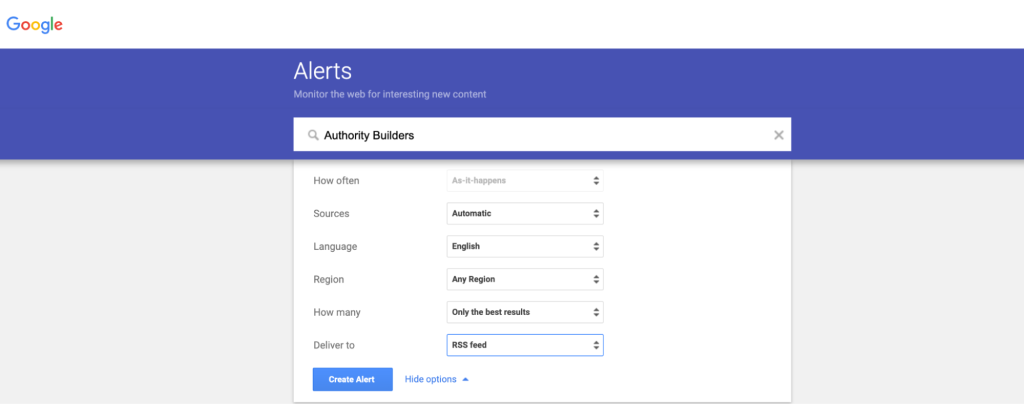
Source: Google Alerts
Go to Google Alerts and enter your brand name, product name, or other relevant keywords.
Next, select how often you want to receive alerts (e.g., as-it-happens, daily, weekly).
Google Alerts will send you email notifications whenever it finds a new mention of your brand online.
| 💡Pro-tip: Use quotation marks around your brand name (“your brand name”) for more precise results. |
Brand24 (Paid)
Here’s a brief overview of how to check for unlinked mentions of your ecommerce website on Brand24.
- Create a project: Sign up for a Brand24 account and create a new project for your brand.
- Add keywords: Enter your brand name, product names, and other relevant keywords you want to track.
- Filter your results: Use Brand24’s filters to narrow your results by source (e.g., social media, blogs, news), sentiment (positive, negative, neutral), and language.
- Explore the mentions tab: This is where you’ll find all the mentions of your brand. You can sort them by date, source, or sentiment.
- Identify unlinked mentions: Look for mentions that don’t include a link to your website.
ℹ️ You can also use Ahrefs, Semrush, and AppSumo to identify unlinked brand mentions.
Prioritize high-quality opportunities
Look for unlinked mentions from reputable websites with high domain authority. These will have the most significant impact on your SEO.
| 💡Key point: What is domain authority?
Domain authority (DA) is a metric developed by Moz that predicts how well a website will rank on search engine result pages (SERPs). It ranges from 1 to 100, with higher scores indicating a greater likelihood of ranking higher. A higher DA is generally better, but what constitutes a “good” DA can vary depending on your industry and competitors. Typically, a DA of 40-50 is considered average, 50-60 is good, and 60+ is excellent. However, it’s most helpful to compare your DA to your direct competitors rather than focusing on an absolute number. |
Ahrefs has its own measure of DA called domain rating (DR). Below, we explained how to check domain rating in Ahrefs:
- Log in to Ahrefs and then click on the “Site Explorer” option located in the top menu. In the Site Explorer search bar, type the domain name you want to check. For example, type “www.shopify.com” and hit enter or click the search icon.
- After the analysis is complete, you will see the domain’s overview page. The domain rating (DR) will be displayed in the top section, along with other metrics like URL rating (UR), backlinks, referring domains, organic keywords, and organic traffic:

Source: Ahrefs
Look for contact details
Once you’ve identified those valuable unlinked brand mentions, the next step is to find the right person to contact. Here’s how you can track down the website owner or author:
🔎 Check the website’s contact page: Most websites have a “Contact Us” page to find email addresses or contact forms.
🔎 Look for author information: If the mention is within an article or blog post, check for an author bio or byline. This often includes links to their social media profiles or personal websites where you can contact them.
🔎 Search social media: Search for the website or author’s name on platforms like LinkedIn or X. You might find their contact information in their profiles.
🔎 Utilize email finder tools: If all else fails, consider email finder tools like Hunter.io or Voila Norbert. These tools can help you find email addresses associated with a website or domain.
Reach out
Now that you’ve located those unlinked brand mentions, it’s time to reach out to the website owners to help you turn them into valuable backlinks.
This requires more than a generic email; it’s about crafting a compelling pitch that resonates individually with each of the website owners you reach out to.
Here are the dos and don’ts of backlink outreach for your ecommerce brand:
✅ Do: Offer value. Highlight any broken links, typos, or other errors you found on their site. You could also offer to publish a guest post by them on your website or offer a backlink in return.
✅ Do: Be polite and personalize your message. Show genuine interest in their website and content. Also, thank them for the mention.
✅ Do: Follow up if you don’t hear back within a few days. A gentle reminder can go a long way.
❌ Don’t: Be pushy or demanding. Remember, you’re asking for a favor.
❌ Don’t: Send generic, impersonal emails. Tailor your message to the specific website and recipient.
Example pitch email
Subject: Quick question about [Article Title]
Hi [Website Owner/Author Name],
I hope this email finds you well.
My name is [Your Name], and I’m the [Your Job Title] at [Your Company].
I recently read your article on [Article Title], and I noticed you mentioned [Your Brand/Product]. Thank you for the shout-out!
I was curious if you’d be open to adding a link to our website, [Your Website URL], alongside the mention? This would help our readers easily find more information about [Your Brand/Product].
I’d also be happy to share your article with our audience on social media.
Thank you for your time, and I look forward to hearing from you.
Best regards,
[Your Name]
Leverage Connectively (Formerly HARO)
Connectively (which used to be known as Help A Reporter Out) is a platform designed to facilitate connections between journalists and sources. Here’s a breakdown of how it works as part of a link-building strategy:
Step 1: Sign up and create a profile
Create a free Connectively account and fill out your profile with your areas of expertise, interests, and contact information.
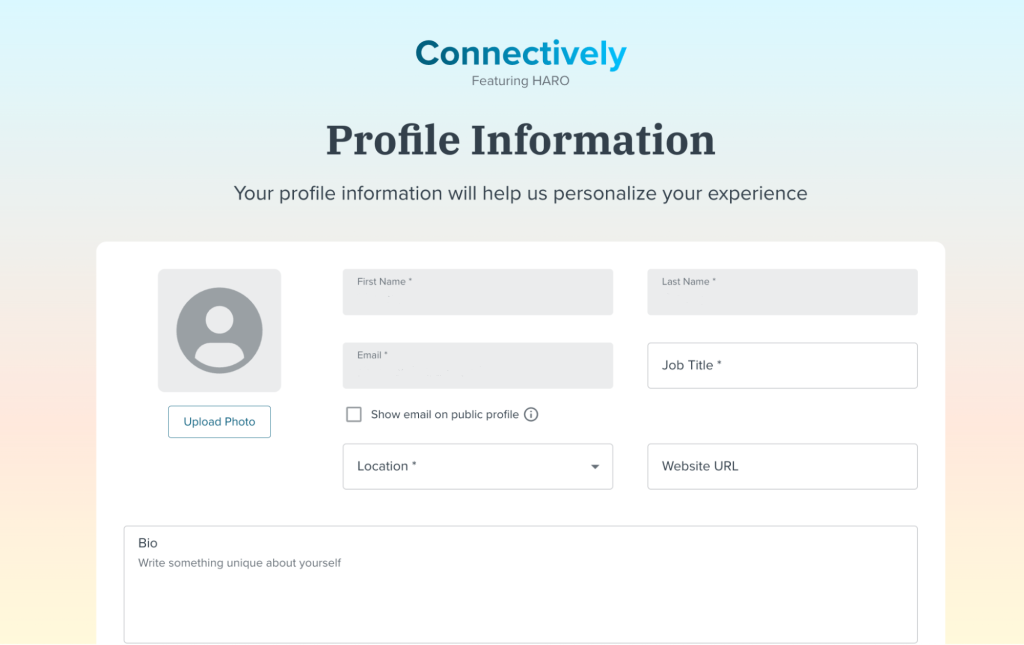
Source: Connectively
Step 2: Browse and filter queries
Explore a feed of media opportunities (queries) posted by journalists seeking experts to interview for their stories. On the dashboard, you can filter queries by keywords, topics, publications, and deadlines to find requests relevant to you:
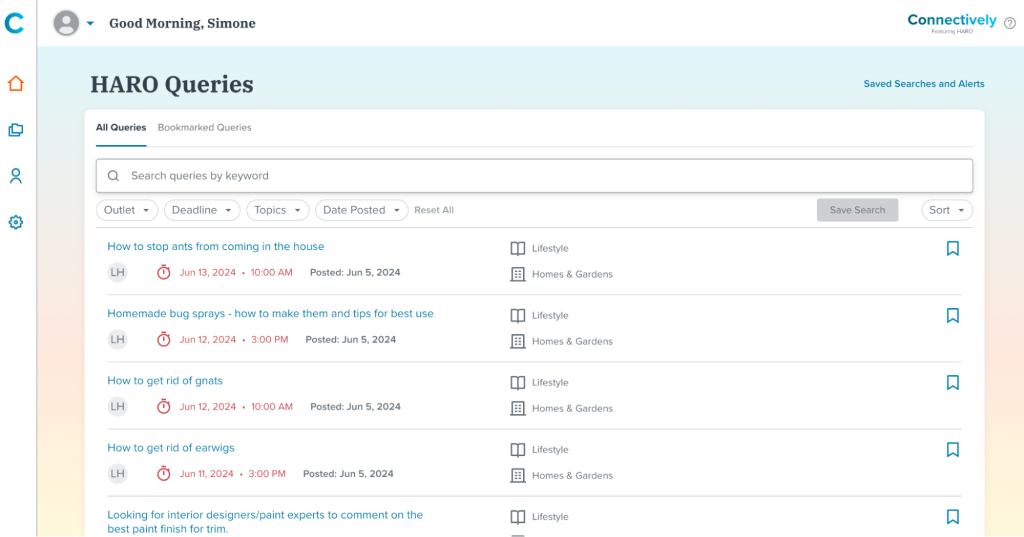
Source: Connectively
Step 3: Craft compelling pitches
When you find a query that aligns with your expertise, craft a personalized pitch highlighting your relevant experience, credentials, and unique insights.
For example, imagine that your ecommerce store specializes in hydration drinks for fitness enthusiasts.
Say you came across the query below seeking expert insights on improving one’s walking routine. You could offer valuable tips on the importance of maintaining hydration to increase performance and stamina during walks:

Source: Connectively
Step 4: Submit your pitch.
Submit your pitch through Connectively’s platform, following any specific instructions the journalist provides.
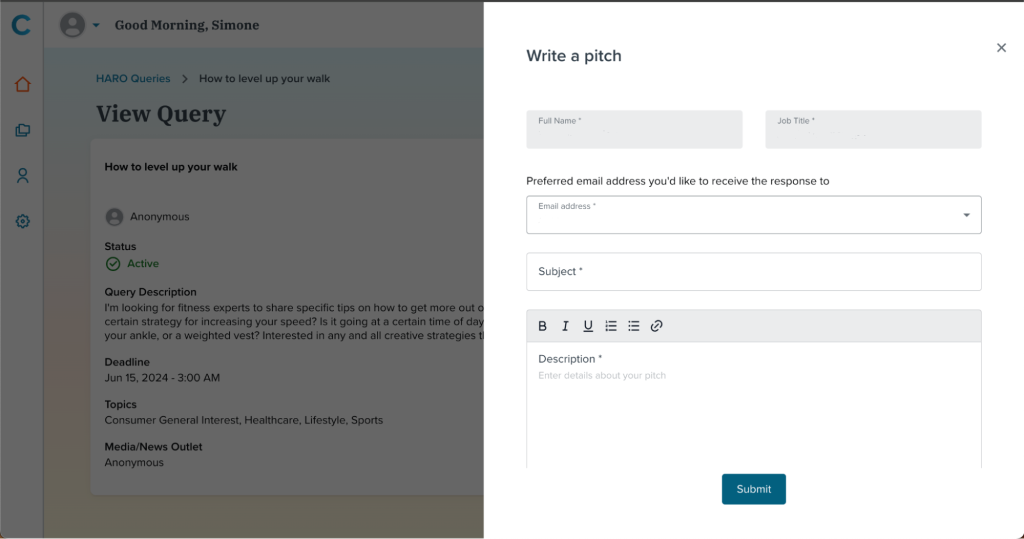
Source: Connectively
Step 5: Track your pitches
You can keep track of your submitted pitches within Connectively’s dashboard to see whether journalists have viewed or responded to them.

Source: Connectively
Step 6: Build relationships
If a journalist selects your pitch, respond promptly and professionally to their inquiries. This is your chance to establish a relationship and potentially secure future media opportunities.
If your pitch is successful, you’ll be featured in the journalist’s article, often with a backlink to your website. Monitor the publication to ensure the link is active and accurate.
| 💡Pro-tip: Promote your success! Share your media coverage on social media and your website to amplify your reach and attract more attention to your brand. |
Broken link building
In the digital world, things are constantly changing. Websites get updated, pages get moved, and sometimes links break. This is where the clever strategy of broken link building comes in.
Broken link building is a white-hat SEO strategy that involves finding broken links on other websites in your niche (links leading to a 404 error page) and offering your relevant content as a replacement.
This benefits both parties: the website owner gets to fix their broken link and improve their user experience while you gain a valuable backlink.
Here’s how it works:
Find relevant broken links
Identify broken links on websites in your niche or industry. You can use tools like Ahrefs, Semrush, or Check My Links to scan websites for broken links. Say you are a nutrition company selling electrolyte drinks. Livestrong.com is a great website in your niche. It’s a high-authority website that gets millions of visitors every month.
Below, we show you how to find broken links in Ahrefs:
Navigate to “Site Explorer” and enter the domain of the website you want to analyze. In this case, it is www.livestrong.com:
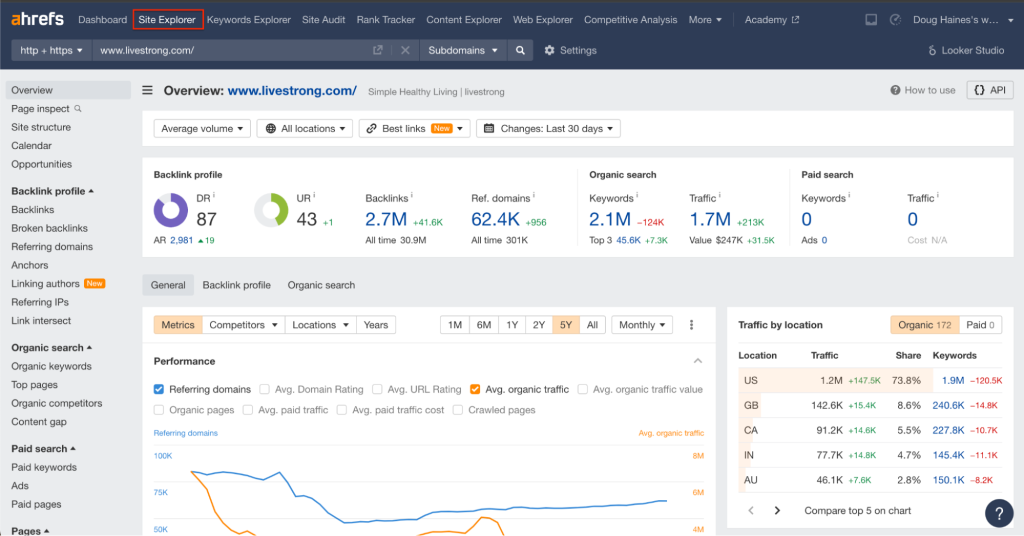
Source: Ahrefs
Scroll down the page. In the left-hand menu, click on “Outgoing Links” and then select “Broken Links.”

Source: Ahrefs
On the left-hand menu of the “Broken Links” page, select “Pages” < “Best by links.”

Source: Ahrefs
Ahrefs will now take you to a page that lists all the broken outbound links on that website, along with their anchor text and HTTP status code:

Source: Ahrefs
What to do next:
➡️ Check the content: Look for broken links pointing to content similar to what you offer on your ecommerce store. For example, if the Livestrong blog has a broken link to an article about the benefits of protein shakes, and you sell protein powder, that’s a perfect opportunity.
➡️ Create replacement content: If you don’t have something to replace the broken link with, then you’ll need to craft a high-quality piece of content on your website.
➡️ Reach out to the website owner: Contact the website owner and let them know about the broken link. Offer your newly created content as a replacement and politely suggest they update the link to point to your page.
ℹ️ See our section above on how to reach out to website owners.
Create high-quality blogs for your ecommerce website
Creating high-quality blog content is the cornerstone of any successful ecommerce link-building strategy.
While videos and infographics reign supreme (more on this below!), the humble blog post remains a powerful tool to drive traffic, establish authority, and attract relevant backlinks. Surprisingly, 77% of internet users still actively read blogs, making it a relevant and effective way to reach your target audience.
A good example of a successful ecommerce blog is Olipop, a drinks company. Its blog contains high-quality content on topics related to its healthy drinks:

Source: Olipop
Here’s how your blog can become a link-building engine for your ecommerce store:
🏆Compelling content = backlinks: High-quality, informative blog posts that resonate with your audience naturally attract backlinks from other websites.
🏆 Internal links: Each blog post serves as an opportunity to strategically link to other relevant pages on your site. This internal linking structure guides both users and search engines through your content, improving the overall SEO performance of your website.
Here’s how ecommerce brands can get started with blogging:
👉🏼 Quality is key: The first step is creating link-worthy content. Craft informative, well-researched articles that address your audience’s pain points and interests. Aim for a minimum of 2,000 words to provide in-depth value.
👉🏼 Optimize for search engines: Conduct keyword research to identify relevant terms your audience is searching for, and incorporate them naturally into your blog posts’ titles, headings, and body content.
👉🏼 Visual appeal: Elevate your blog posts with eye-catching images, infographics, and videos to enhance reader engagement and encourage social sharing.
👉🏼 Spread the word: Share your blog posts across social media channels, email newsletters, and relevant online communities to maximize their reach and attract backlinks.
👉🏼 Keep it fresh: Regularly update older blog posts to maintain relevance and ensure a consistent flow of fresh content to keep your audience engaged.
Invest in influencer partnerships
One of the most effective ecommerce link-building strategies is influencer marketing. In essence, it’s collaborating with individuals with a strong online following to promote your products or services.
A great example of an influencer partnership would be if a favorite YouTuber or Instagram influencer whom you follow, tells you how much they love HelloFresh—you’ll take note.

Image courtesy of Heepsy
According to a survey, 89% of marketers believe that the ROI from influencer marketing is comparable to or better than other marketing channels.
When executed effectively, it can help ecommerce businesses obtain high-quality backlinks from the influencer’s website or social media channels.
These backlinks not only drive referral traffic, but also signal to search engines that your website is trustworthy and relevant, boosting your SEO rankings.
How to leverage influencers for ecommerce link building
If you’re ready to dip your toes into influencer marketing, here are some essential tips to ensure a successful campaign:
✨ Find the right influencer: Don’t be swayed by follower count alone. Choose influencers who align with your brand values, target audience, and niche. Use tools like BuzzSumo, Upluence, or AspireIQ to connect with potential partners.
✨ Quality content: Only collaborate with influencers who consistently produce high-quality content that resonates with their audience.
✨ Authenticity matters: Encourage influencers to create genuine content that reflects their personal style and voice. Avoid overly scripted or promotional content.
✨ Understand their audience: Ensure the influencer’s followers are real and engaged, not just bots or fake accounts.
✨Make it worthwhile: Provide influencers with fair compensation, exclusive perks, or other incentives to ensure a mutually beneficial partnership with your ecommerce website.
Digital PR link building for ecommerce
Press links, also known as PR links or earned media links, are backlinks that come from online news publications, magazines, blogs, or other editorial websites.
They are a form of digital PR and are considered highly valuable for SEO because they:
➡️ Come from authoritative sources. Reputable news outlets and publications are high authority sites, which means search engines view links from these sources as more trustworthy and relevant.
➡️ Are editorially placed. Unlike paid links or directory submissions, press links are earned through genuine interest in your story or content, which means they are more organic and natural.
Here is how to get press links
Product reviews and roundup articles
This is when a journalist or blogger writes about your product and includes a link to your website. Your product or service could also be included in a curated list of recommendations— take this BuzzFeed Shopping listicle as an example:
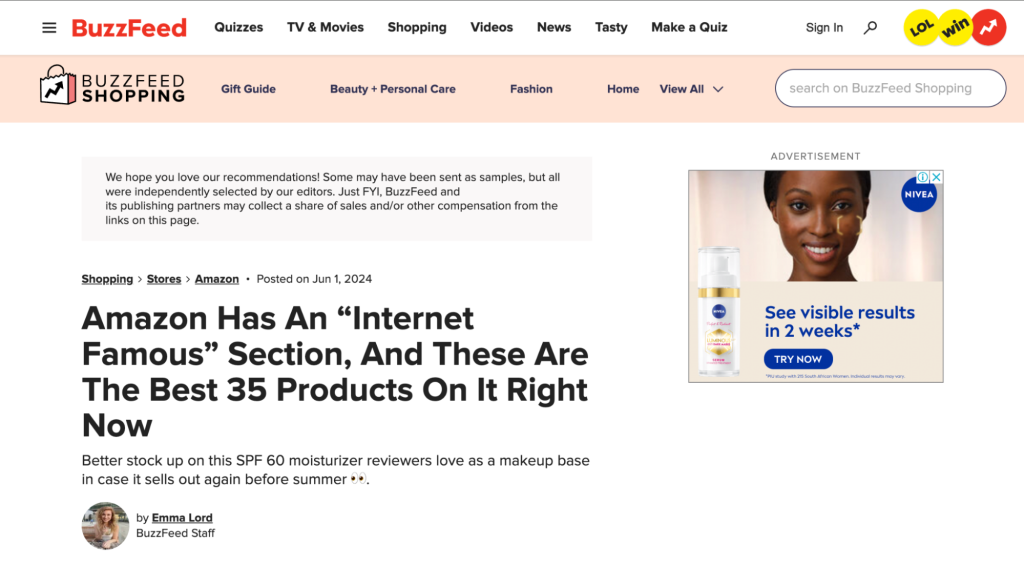
Source: BuzzFeed
News articles
Your company or product is mentioned in a news story with a link to your site. This can also include an interview where the publication links to your website.
Thought leadership content
By publishing high-quality content like research studies, white papers, or opinion pieces, you increase the likelihood that journalists might reference you and link to it.
A fun example of this is the AllAboutCats.com’s wealthiest pets list. Many news outlets picked this research piece up and it created a lot of buzz:

Source: Rolling Stone
Press releases
While not as valuable as organic press mentions, some press release distribution platforms can still generate backlinks from smaller news outlets.
| 💡Key point: Links generated from automated press releases often end up on low-quality, content-spinning websites that provide no real SEO benefit, so we recommend not doing press releases in an attempt to get high quality links. |
You may think that all of the above sounds difficult, and it is.
Earning press links is a nuanced process. While some aspects of digital PR can be tackled in-house, many ecommerce businesses find that partnering with a professional PR agency is the most effective way to secure consistent, high-quality media coverage and backlinks.
Create linkable assets
Lastly, staying with high-quality content, our final ecommerce link-building strategy is to create linkable assets.
While blogging and PR generally fall in this category, consider creating these link-worthy types of content for your ecommerce site:
✅ Infographics: Visually engaging data summaries that are easily shareable.
✅ Statistics pages: Curated data hubs that serve as go-to resources for industry information.
✅ Data studies/analyses: Original research that provides valuable insights.
✅ Interactive tools: Calculators, quizzes, or other interactive elements that offer utility.
✅ Video content: Engaging videos that educate, entertain, or inspire.
By producing valuable content that others want to reference, you create a steady stream of organic backlinks that enhance your website’s authority and visibility in search results.
Final Thoughts: Ecommerce Link Building
As we’ve pointed out, link building isn’t just an SEO tactic—it’s a powerful growth engine for ecommerce businesses. You can significantly enhance your website’s visibility, authority, and organic traffic by strategically building bridges with other websites through high-quality content, influencer partnerships, and digital PR efforts.
Remember, link building is a marathon, not a sprint. It requires consistent effort, creativity, and a focus on building genuine relationships. But the rewards—increased brand awareness, higher search rankings, and, ultimately, more sales—are worth the investment.
Ready to take your link building to the next level?
If you’re looking for expert guidance and support in your link-building journey, consider partnering with Authority Builders Co. Our team of seasoned professionals specializes in crafting tailored link-building strategies that deliver measurable results. Sign up today.
